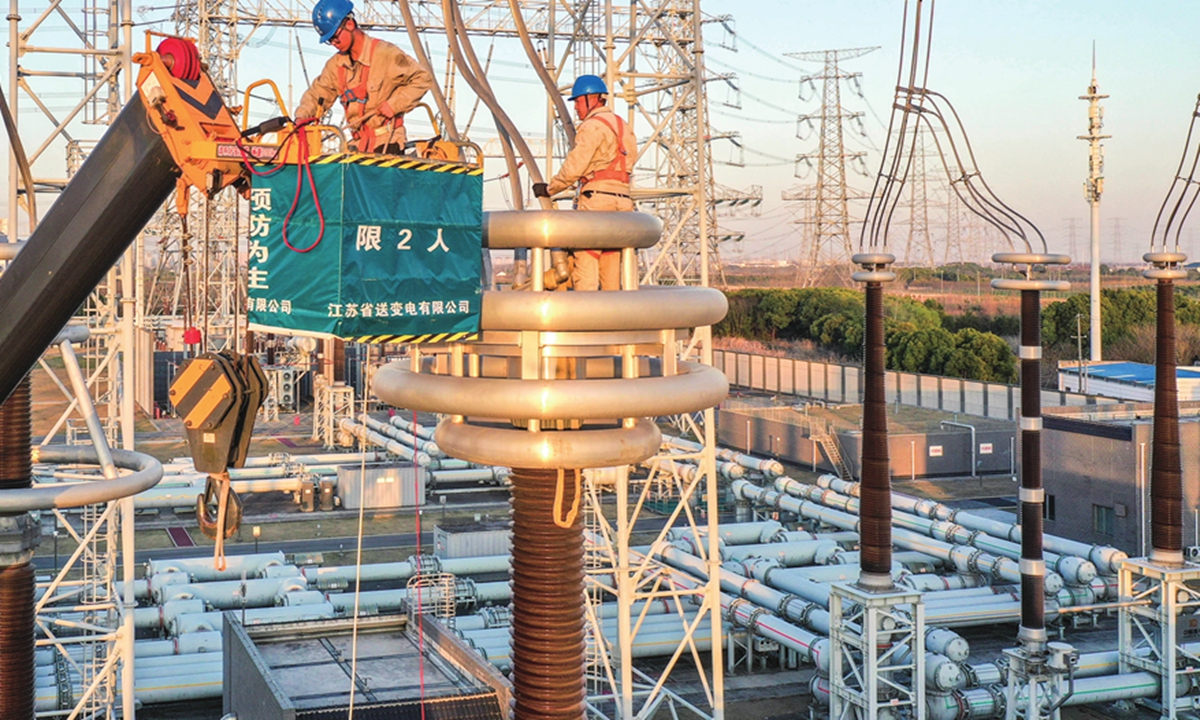
Workers check a 1,000-kilovolt ultra-high voltage electricity transmission line in Suzhou, East China's Jiangsu Province on March 15, 2023. Cities in China are starting seasonal power checks to ensure a stable power supply for the summer. Photo: cnsphoto
With surging demand for electricity, power supply in some regions of China is becoming tight. But industry analysts said that the overall power supply will be sufficient and electricity generators vowed to strive to keep up with increasing demand.
This year's electricity consumption will definitely be higher than that in 2022 as all kinds of industries, especially energy-intensive production enterprises, are recovering, Sheng Honglei, associate manager of CyberInsight New Energy Technology Co, told the Global Times.
China Southern Power Grid said on Monday that supply has been tight so far this month in South China's Guangdong Province, a major manufacturing hub and big electricity consumer.
The power supplier is working with State Grid Corp to strengthen supply across provinces. Guangdong is receiving 1 million kilowatts of power every day from neighboring Fujian Province in East China starting from Saturday and lasting for 19 days.
Growth in electricity use in the second quarter is likely to pick up significantly, driving first-half growth to about 6 percent, according to an analysis of the national power supply and demand situation released by the China Electricity Council (CEC) on April 28.
In terms of power supply, uncertainty exists in terms of precipitation, resources of wind and solar, and fuel supply. Under normal weather conditions, China's maximum power load is expected to be about 1.37 billion kilowatts in 2023, an increase of about 80 million kilowatts over 2022, said CEC. Some regions may witness tight power supply in peak hours, especially in the southern part of China, the council said.
Sheng said that provinces that rely on hydropower may face a tough challenge this year, as the meteorological department predicts regional droughts from June to August. But he noted that there should be no problem with overall supply in 2023.
"Big state-owned power groups are striving to find high-quality coal to ensure stable thermal power supply. Meanwhile, the number of approvals for new-energy projects, such as wind power and photovoltaic projects, has increased," said Sheng.
A manager with the Port of Lianyungang in East China's Jiangsu Province said that seaborne coal imports increased by some 80 percent year-on-year during the first four months of 2023, and noted that the nation's overall coal supply-demand balance is not tight.
Southwest China's Sichuan Province, which was heavily reliant on hydropower and suffered from a tight power supply in the summer of 2022 due to drought, prioritized wind and solar power project construction as it faced a predicted drought in 2023.
By the end of 2022, 97 power grid projects with a total investment of 106.7 billion yuan ($15.3 billion) had been approved in Sichuan, the province's top economic planner said in April.
In April, China generated 658.4 billion kilowatt-hours of electricity, up 6.1 percent year-on-year, according to data released by the National Bureau of Statistics on Tuesday. While coal-fired, nuclear and wind power increased, hydro and solar power saw a decline in April.
According to the National Energy Administration (NEA), China added 59 million kilowatts of installed power generation capacity in the first quarter, with 50.5 percent of that being non-fossil power generators.
As of the end of March, China's total installed generation capacity was 2.62 billion kilowatts, up 9.1 percent year-on-year, NEA statistics showed.
The increasing capacity led to a rise in power supply. In the first quarter, power plants above designated size generated 2.07 trillion kilowatt-hours of electricity, up 2.4 percent year-on-year, according to the CEC.
Non-fossil generation increased by 8.9 percent year-on-year in the first quarter, and coal power generation accounted for 60 percent of total power generation.
Chen Guibin, a representative from Guangdong-based Dongguan Chaojie Silicon Rubber Products Co, told the Global Times on Sunday that his factory has not received any notification about any temporary power outage so far this year.
Chen noted that local factories have to temporarily suspend production at peak times each year to secure households' power usage.
An anonymous representative from a thermal power plant in Hohhot, North China's Inner Mongolia Autonomous Region, told the Global Times that the pricing mechanism for electricity has been revised from long-term contract trading to spot trading.
Under the new mechanism for 2023, the electricity rate will change according to demand and other factors that may affect the cost of power generation, and may ease the negative influence caused by surging coal prices, he said.



